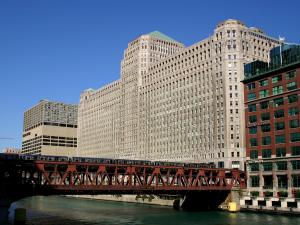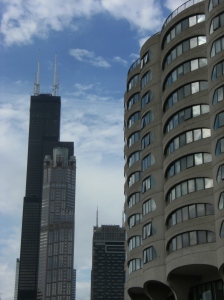I thought it would be nice to write reviews of all the touristy things we do in Chicago, as a kind of resource for our visitors and fellow tourists. So here is review no. 1 (rather delayed) on the Chicago Architecture Foundation (CAF) river cruise, one of those tourist staples. We did it on Labor Day.
You get the general idea here. This guy, Alan, is just beginning our tour, from the pier next to the Michigan Ave. bridge over the Chicago river. It’s pretty pricey – nearly $40 a ticket. We justified the expense because it was our wedding anniversary, and celebrating marital union is all about spending money, right?
The nice thing is that it combines architecture and a bit of Chicago history. So you get to hear about Louis Jolliet as the first European migrant to visit the stinky onion grass region (onion grass called something like ‘Chicago’ in the native language) where you could cross from the Great Lakes to the Mississippi; the 19th century population explosion (from 4,500 to more than 1 million between 1840 and 1860); the Great Chicago Fire of 1871, caused by Mrs O’Leary’s kicking cow; the coming of the railway. All this would, I think, be tedious to someone who lived in Chicago, but it’s good for the newcomer.
Alan the guide (actually, CAF like to call them ‘docents’, for some pseudo-intellectual reason), did a great job of explaining the engineering feat of reversing the flow of the Chicago river at the turn of the 20th century. In Obama’s memoir, he claims that he left Chicago (the first time round) not knowing why the river flows backwards out of Lake Michigan. I’m sure this is disingenuous. Anyway, it turns out it’s all to do with keeping the Lake, and thus the drinking water, pollution free. Alan the docent claimed the plan followed a cholera epidemic after a flood in 1885, but Wikipedia says there was no actual epidemic: just a panic.
Anyway, it was an inspired Victorian solution: let’s build a canal and send all the effluent down the river to St Louis. St Louis were mounting a legal case to stop them but weren’t fast enough for the Chicagoans and the dynamite that blasted the canal into the bedrock. And, according to Alan, it fortunately turned out that St Louis was far enough away that the water was clean by the time it got there. But Chicago’s appropriation of the waters of Lake Michigan still seems to be an inter-state point of tension today, and Mayor Daley is now proposing to reverse the river once more.
OK – enough about the river. There was mainly a lot of architecture. Alan said there were four architectural styles we needed to know about: Beaux-Arts, Art Deco, Modern and Postmodern.
I never really understood what Chicago building, other than Union Station, was meant to be Beaux-Arts, but we had a good look at what I would have thought of as neo-Gothic: the Tribune Tower (right, below) and the Wrigley building (left).
I was introduced to the lovely term ‘armchair building’, in the form of the Civic Opera House (below), which we sailed past twice – the idea, apparently, is that it avoids concrete canyons if you set the higher storeys (or back of the chair) back from the street and create a low central level (seat of the chair) with medium-height towers/arms at either side.
(Image above copyright Jeremy Atherton, 2006.)
So, that’s an Art Deco building, and so is the MerchMart:
(Image by J. Crocker, 2007).
But, really, what did either of these have to do with what Alan claimed was the motto/summary of the Art Deco style, ‘look up’? Did he just make it up? I really want to know, architecture buffs.
Then there was the modern. M and I tried and failed to fall for Mies van der Rohe and his many plain Gateway buildings. (I made more of an effort, I’d say, but that’s just my inner arty swot coming out.) Alan claimed the motto for this was ‘less is more’, which I always thought had to do with Donna Karan in the 90s, but I now see people actually attribute to Mies on the internet. (What has it come to when I trust the internet more than a real life docent?) Still, we reserved our derision for the postmodern Roman temple-referencing building in reflective glass, which thankfully I can’t scorn at great length since I can’t remember either its architect or address.
But we fell for the curves of Marina City and River City (or as I like to think of the latter, my friend K’s old block – foreground, below). Alan claimed Bertrand Goldberg, their architect, invented the phrase ‘in nature there are no straight lines’. This is manifestly untrue. But the more I read about Goldberg (whom Alan made out to be a rebel against Mies), the more I like him too.
And finally, the Sears building (left above), and the story that it was inspired by a pack of cigarettes pushed up to different heights. Probably bollocks, but the kind of anecdote I like.
Overall it was a fun tour. Alan needs to slow down and stop reeling off a new firm of architects every 30 seconds. He also told us at least fifteen times – probably closer to fifty – that people didn’t value the river until the 1980s, and that this explained the poor river frontages of a zillion buildings. We had grasped the point after five mentions, I think. But it’s easy to criticise, as any lecturer knows. We got a lot out of it – and best of all, it didn’t rain.





